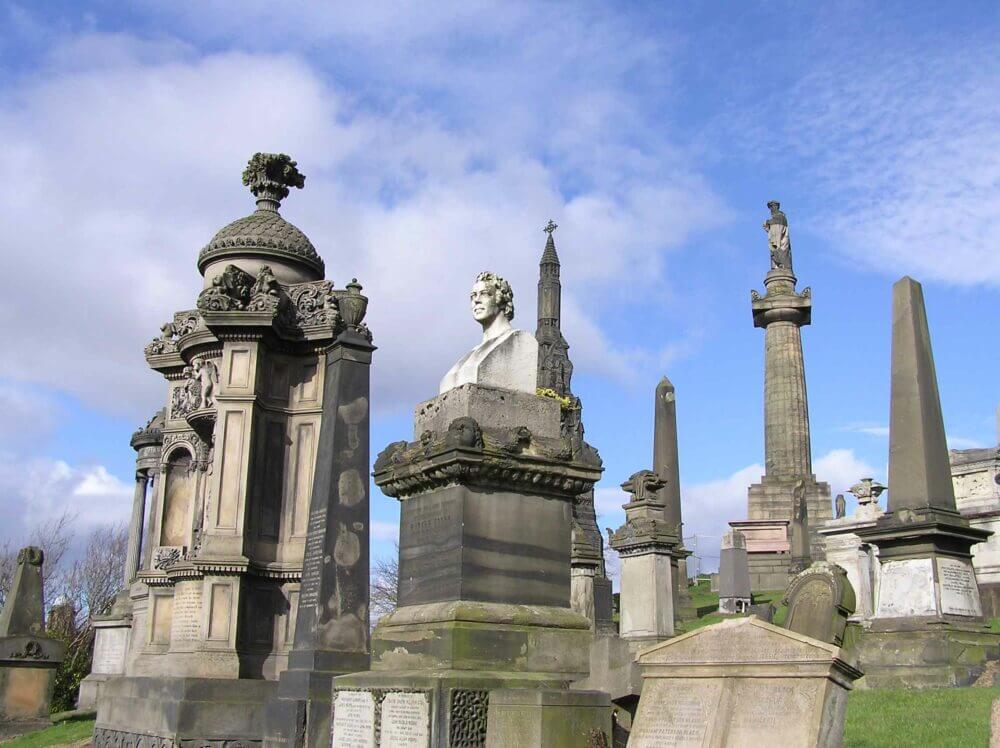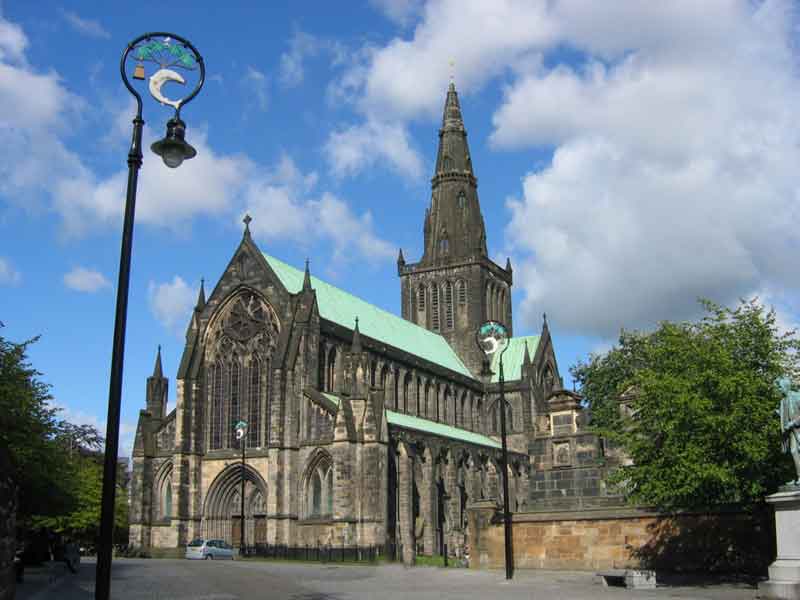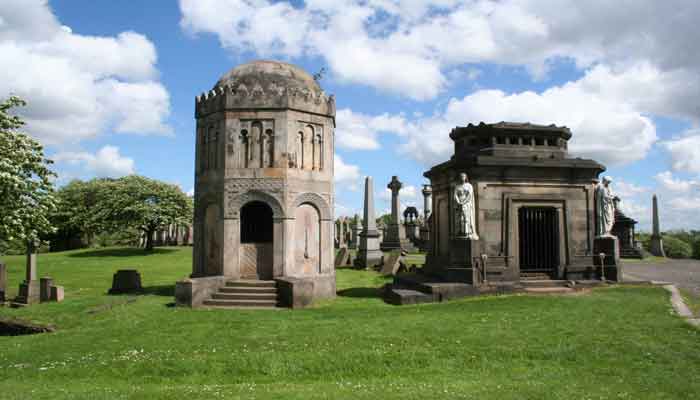Glasgow Necropolis was described as a “unique representation of Victorian Glasgow.”

This vast cemetery, now one of the city’s favourite visitor attractions, sits on a hill overlooking Glasgow Cathedral.
It’s the site where in the 6th century St Mungo built his first wooden church and baptised his Christian converts in the Molendinar Burn.
Built when Glasgow was the second city of the empire, it reflects the feeling of confidence, wealth and security of the time.
Glasgow Necropolis: its history
Although the first burial was in 1832 the Necropolis’s story begins much earlier.
It was in 1650, the year of Oliver Cromwell’s victory over the Scots at the Battle of Dunbar, that the Merchants House of Glasgow, founded 45 years earlier, bought part of the estate of Easter and Wester Craigs from Sir Ludovick Stewart of Minto.
It paid the princely sum of 23,250 Scottish merks (£1,300 sterling).
Merchants House of Glasgow
The Merchants House, today still a vibrant charitable organisation, with imposing offices in the city centre, was founded to protect the interest of the city’s merchants while providing assistance for their members and their families when times were hard.
Until 1833, it worked closely with what was then Glasgow Town Council
Sections of the newly acquired land were used to quarry rock; other areas which overlooked the cathedral were planted with fir trees and became known as Fir Park.
The rocky section of the estate has opened an, as yet, unresolved debate over the origins of the name Glasgow. Traditionalists may argue Glasgow is the “dear green place” while some scholars have suggested a different meaning.
The British Geological Survey offers a technical explanation, “The Necropolis sits on a hill formed by a resistant microgabbro sill dated at 273 million years old. An early name for that hill was ‘the Grey Rock after the dull color of the crags.

Consequently, one interpretation of the name ‘Glasgow’ is the ‘place of the grey rock’ suggesting the city was named after this prominent geological feature.”
Glasgow, at that time, was a city starkly divided between those who had and those who had not; a city which although enjoying the fruits of the Industrial Revolution was weighed down by growing social problems.
As the population almost tripled in size between 1800 and 1830, overcrowding brought disease and a rising death rate. In November 1832, for example, 3,000 people died of cholera.
By 1841 the city had the highest death rate in Scotland.
J. C. Symons, a London lawyer visiting the city in 1839 said “I have seen human degradation in some of its worst phases, both in England and abroad, but I can advisedly say that I did not believe until I visited the wynds of Glasgow that so large an amount of filth, crime, misery and disease existed on one spot in any civilized country…”
In contrast, James Johnson, also from London heaped praise on many of the city’s finest buildings describing them as “well deserving of the traveler’s attention.”
Change, including its burial provision, came slowly as the city tried to throw off its unsavory image prompting social historians to argue that the Necropolis cannot be viewed in isolation.
It was one step, along with clean water, gas lighting and other measures, on Glasgow’s journey of improvement.
Glasgow Necropolis: John Knox
In 1825, before the opening of the cemetery, a statue of John Knox, standing on a sandstone Doric column (58 feet), was erected at the highest point of Fir Park and gazes sternly out over the cathedral, the only medieval cathedral to have survived the Reformation almost intact.
One inscription on the base reads “the Reformation produced a revolution in the sentiment of mankind the greatest as well as the most beneficial that has happened since the publication of Christianity.”
He said, “The interest shown in this ceremonial was of no ordinary nature; the streets through which the procession passed were so crowded that it was with Pedigree difficulty that subscribers could move along… Every window was filled with spectators… The scene was truly magnificent…”
While the statue, conceived as a reminder of his connections with the University of Glasgow, dominates the Necropolis, Knox wasn’t buried in Glasgow; he is believed to lie under what is now a car park behind St Giles’ Cathedral in Edinburgh.

A proposal that Fir Park be transformed into a “burying ground” similar to the celebrated Père Lachaise in Paris” appeared, in the form of a cartoon, in July 1825 in the Looking Glass, a short-lived satirical magazine that observed the political and social ‘eccentricities’ of Glasgow.
This was three years before the first informal discussions by members of the Merchants House.
Despite a rather complex ‘back story’ including what the academic David Scot called the “possible influence of Freemasonic ideas,” the Necropolis project came to the official notice of the Merchants House, Necropolis Committee in October 1829.
While a number of men of varying trades and experience were involved in the initial stages, James Ewing, a West India merchant and Freemason, elected Dean of Guild of the Merchants’ House, was one of the driving forces behind the project.
Others included Laurence Hill, Collector of the Merchants’ House, who may have had a hand in the Looking Glass article and James Cleland, a town council officer.
The proposed plan was, bearing in mind the desperate state of existing burial provision, not driven by social conscience but firmly based on profit, it was a venture clearly designed for the growing middle class.
The report presented to the directors suggested that 800 tombs costing £25 each would yield a total of £20,000 to the House.
In 1830, a detailed model of the Père Lachaise went on show in the city’s Argyll Arcade.
It was a chance for Glaswegians to see a representation of which opened in Paris in 1804 and is now the final resting place of such luminaries as Edith Piaf, Oscar Wilde, Isadora Duncan and Marcel Proust.
At the time it was described as “the most magnificent burial ground in the world.”
Anon
The committee decided the best way forward was a competition and in January 1831 placed advertisements in a number of newspapers inviting designs, required by 13 April (a date later extended), which would turn Fir Park into an“ornamental cemetery on the principle of the Père Lachaise in Paris.” ‘Premiums’ would be awarded to the best submitted designs.
Before the final judging, the 16 entries were put on show in the Dilettanti Society’s Exhibition Rooms in the Argyll Arcade.
In the end, although the five best were selected and prize money paid, no overall winner was chosen.
Instead, the committee arranged for the best elements from all five to be combined. It would be a “Scottish Père Lachaise” an expression coined by John Strang in his 1831 book, Necropolis Glasguensis.
In January 1832, the Necropolis Committee, finally satisfied, recommended that an “experienced gardener should be employed to lay out the cemetery.” In May, George Milne was appointed Superintendent and Head Gardener at a salary of £60 a year.
The opening of the Necropolis marked the “culmination of more than 30 years of expansion and improvement in Glasgow’s burial provision.” Previously the disposal of the dead in Scotland was carried out almost entirely by burial in churchyards which were in the main becoming overcrowded and insanitary.
Joseph Levi, first burial at Glasgow Necropolis
The first, of about 50,000 people, to be buried in the cemetery was Joseph Levi, a Jewish quill merchant, yet another Glaswegian who succumbed to cholera in September 1832.
The first Christian burial came in February of the following year when Elizabeth Miles, stepmother of George Milne was interred. Milne’s sister and young son were buried soon after.
Some months after Levi’s burial the Merchants House advertised that it was “ready to treat for the disposal of lots or burial places.”
This same notice highlighted the “very efficient nightly guard,” It was an important selling point, for despite the Anatomy Act of 1832, which gave doctors and anatomy teachers easier access to cadavers, there was still a very real fear of body-snatching.
People well remembered the activities of Burke and Hare in Edinburgh and surgeon Granville Sharp Pattison who stood trial in Glasgow for body-snatching in 1814.
Glasgow Necropolis opened, without ceremony in May 1833. It had an “air of melancholy gloom” said one contemporary writer.
George Milne was congratulated by the Merchants House for his “taste, diligence and economy” he had shown in his preparation. However, Milne’s relationship with the House wasn’t always as comfortable. During his tenure, there were a number of disagreements over his role and finally in February 1842 he ‘departed’.
Bridge of Sighs
Initially, entrance to the cemetery was difficult until in 1833 a bridge, the Bridge of Sighs, was built over the Molendinar Burn, joining the cathedral to the cemetery.
The ceremony in October 1833, surrounding the setting of the bridge’s foundation stone was elaborate, carried out in “the presence of a great concourse of the citizens.” As part of the occasion, a bottle with a message was set in the foundation stone. It “evoked continuity with Glasgow’s past, from the burial grounds around the High Church (cathedral) to the new cemetery.”
The bridge’s name is intriguing; some believe it was named after the Ponte dei Sospiri in Venice, more likely is that it was so named because of the sadness of the funeral processions moving from the cathedral to the cemetery.
The Molendinar Burn central, as a water supply, to the development of the medieval city is today covered and runs in a culvert under the bridge in what is now Wishart Street.
It’s a street named after George Wishart a Scottish reformer, friend and confidant to John Knox.
Wishart was burned at the stake in 1546 at St Andrews.
William Miller: Wee willie Winkie
The Necropolis, today controlled by Glasgow City Council, is full of surprises.
While many of the graves and monuments are testament to the lives of powerful figures, the monument, small in comparison to others, of poet William Miller, (1810-1872) author of the nursery rhyme Wee Willie Winkie is particularly special for those who remember the words. They are a reminder of childhood days.
Miller’s memorial is modest in comparison to some of the other 3,500 that pepper the site. Some of the most elaborate were designed by the greatest architects of the day, including Alexander ‘Greek’ Thomson, Charles Rennie Mackintosh and John Bryce.
Modeled on a Knights Templar church
One which fits easily into the elaborate category is the Monteath mausoleum, a neo-Norman rotunda modeled on a Knights Templar church; its external decoration reflects a strong Hindu influence with 48 Dwar Palas (door keepers or guards) keeping watch.
This ornate, if slightly neglected, structure, now the subject of a restoration project by the Friends of Glasgow Necropolis, is the final resting place of two brothers, Major Archibald Douglas Monteath who died in 1842 and his brother James Monteath Douglas who died in 1850.
Major Monteath, in particular, has a ‘colourful’ background. An officer in the East India Company he was said to have made his fortune when an elephant carrying a Maharajah’s treasure was ‘relieved’ of its load after being stopped by him.
It’s a wonderful story but sadly almost certainly an apocryphal one.
The seated figure of a pensive Charles Tennant (1768-1838) looks out over the cathedral and is a reminder of Glasgow’s industrial heritage.
As the owner of one of Europe’s largest chemical works, Tennant was a powerful figure in the Industrial Revolution.
Nearby is the memorial, a neo-gothic tower, to Duncan McFarlan (1771-1857), minister, Principal and Vice-Chancellor of Glasgow University, the man who welcomed Queen Victoria to Glasgow Cathedral in 1849.
Of course, Monteath Tennant and McFarlan are only three among many, but every monument or simple gravestone marks the passing of somebody who played their part in Glasgow’s story and it’s hard not to be drawn into their lives too.
FRIENDS OF GLASGOW NECROPOLIS – VISITOR INFORMATION
For information on opening hours and other tips to help you plan your visit, go to the Necropolis website.